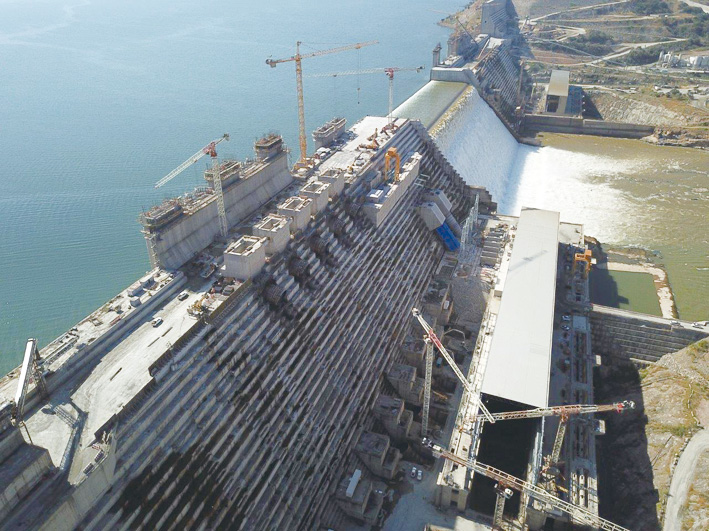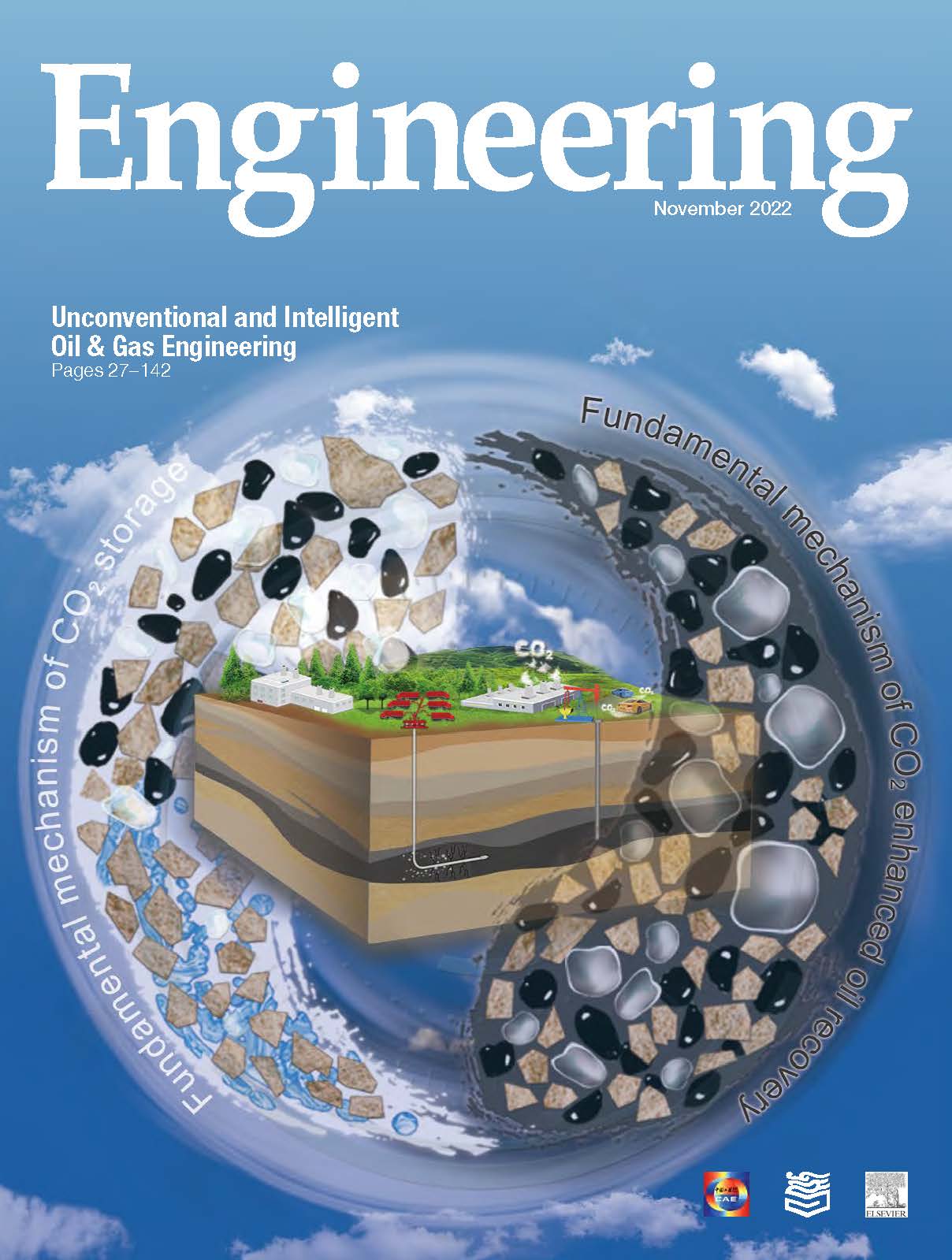February 2022 saw the first official electricity produced by what will be, once fully operational, Africa’s largest hydropower dam, the Grand Ethiopian Renaissance Dam (GERD) (Fig. 1) [1]. It is just one of the latest milestones in an ongoing global boom in a hydropower dam industry pulled from the doldrums by the urgent need to produce climate-friendly energy for a global population with a growing demand for electricity [2].
《Fig. 1》

Fig. 1. The GERD, during construction by Webuild Group (Milan, Italy) for Ethiopian Electric Power, is nearing completion. In this photograph, water pours through the emergency spillway, and the long grey oblongs on either side are the locations of the dam’s two powerhouses. Credit: Webuild Group (public domain).
Constructed with roller-compacted concrete [3], GERD sits on the Blue Nile in the western region of Benishangul-Gumuz in Ethiopia, 15 km from its north-western border with Sudan. Construction of the 1800 m long and 170 m high dam began in 2010, and its multi-year filling process commenced in July 2020 [4]. When the filling of the dam is complete, expected to take several more years and strongly dependent on river conditions, its reservoir will cover about 1900 km2 and contain approximately 7.4 × 1010 m3 of water.
GERD’s powerplants sit at its base, one on each side of the river. Their combined 13 Francis hydroturbines are expected to produce as much as 5.15 GW, essentially doubling the country’s existing capacity and serving as an engine for Ethiopia’s economic development [5,6]. Since its inception, however, the project has created international political turmoil and concern across the wider region, not least as nations downstream of the dam, Sudan and Egypt, attempt to protect their own stakes in the critically important waters of the Nile [7].
Meanwhile, in China, another new hydropower megaproject is nearing completion. The Baihetan Dam (Fig. 2), built and run by the China Three Gorges Corporation, is the second of four cascading hydropower stations on the Jinsha River (the upper sections of the Yangtze River). About 180 km downstream of the 10.2 GW Wudongde Dam and hydropower station—another Three Gorges Corporation project which itself became fully operational in 2021—the Baihetan Dam site stretches across Ningnan County, Sichuan Province, and Qiaojia County, Yunnan Province. Dealing with a deeper, more mountainous reservoir than GERD, Baihetan’s concrete arch curves not only in the horizontal direction but also in vertical direction; measuring 289 m at its highest point, the dam’s reservoir capacity is 2.06 × 1010 m3 [8].
《Fig. 2》

Fig. 2. The Baihetan Dam in June 2022 when it passed a 72 h trial and started formal operation of half its total complement of 16 Francis turbines, each with a generating capacity of 1 GW. When all 16 of these world’s largest turbines are in operation, expected by the end of 2022, the dam will become the second-largest hydropower generator in the world. Credit: China Three Gorges Corporation (public domain).
Each of Baihetan’s two powerhouses contains eight 1 GW Francis turbines, giving it a maximum operating capacity of 16 GW. To provide a sense of scale, in 2020, the United Kingdom’s total generation capacity from all sources was 76 GW [9]. The Baihetan hydropower turbines are the largest in the world. A single unit, made up of the turbine, a generator, and associated equipment stands 50 m tall and weighs 6800 t [10]. For comparison, the capacity of the world’s largest wind turbine, entering commercial production in 2024, will be 15 MW [11]; a wind farm using such turbines would require more than a thousand of them to reach a capacity of 16 GW.
‘‘The suppliers of electro-mechanical equipment for hydropower projects are really pushing the envelope in the size of their turbines,” said Ajay Chaudhary, hydropower account lead at the Croydon, UK-based global engineering firm Mott MacDonald. ‘‘They are working at a scale at which you need to rethink everything from first principles, from the hydraulics to logistics and constructability of the turbines inside the powerhouse.”
The first two of Baihetan’s turbines began operating in July 2021. In May 2022, another six began operating, bringing its capacity to 8 GW. When the plant becomes fully operational in late 2022, it will be the second largest hydroelectric power station in the world, behind China’s Three Gorges Dam, the 22 GW behemoth spanning the Yangtze River in central China.
These projects represent the pinnacle of civil engineering challenges, said Chaudhary. ‘‘Hydropower requires expertise in the disciplines of mechanical, electrical, communications, transmission lines, substations, access roads, bridges—and you are also dealing with the river gods! The number of engineering specializations required to bring a project like this together is extraordinary.”
According to the Paris, France-based International Energy Agency, China will account for 40% of the global capacity growth in hydropower between 2021 and 2030, remaining by far the dominant player in this sector [12]. Indeed, China’s global impact on the hydropower industry is enormous—it is heavily involved in both the financing and the building of hydropower facilities all over the world (Fig. 3).
《Fig. 3》

Fig. 3. China’s support of hydropower projects around the world is significant, as suggested by this figure showing the country’s estimated involvement in owning, financing, and constructing hydropower project capacity from 2021 to 2030. Credit: International Energy Agency, with permission.
In addition to accounting for the vast majority of humanity’s energy storage capacity, hydropower also provides about half of all low-carbon electricity generation, contributing about 55% more than nuclear generation, and more than all other renewables combined (Fig. 4) [12]. In absolute terms, hydropower generated 17% of global electricity in 2020, third behind coal and natural gas [12].
《Fig. 4》

Fig. 4. Low-carbon electricity generation by technology in 2020. Hydropower contributes more than all other renewables combined, and about 55% more than nuclear power. PV: photovoltaic. Credit: International Energy Agency, with permission.
But while the global hydropower industry is booming today, as recently as the late 1990s the negative social, economic, and ecological impacts of large hydropower projects, and a lack of international standards on water stewardship and sustainability had created a high degree of social and environmental upheaval and concomitant legal fights. These issues led the World Bank, a major hydropower funder based in Washington, DC, USA, and the World Conservation Union, based in Gland, Switzerland, to arrange a summit including representatives from both sides of the debate [13]. That meeting resulted in the creation of the World Commission on Dams (WCD), which existed from 1997 to 2001.
Regarding the environment, the commission’s final report in November 2000 [14], while acknowledging the benefits of dams, also highlighted that ‘‘Large dams generally have a range of extensive impacts on rivers, watersheds, and aquatic ecosystems—these impacts are more negative than positive and, in many cases, have led to irreversible loss of species and ecosystems.” Regarding people, the WCD highlighted ‘‘Pervasive and systematic failure to assess the range of potential negative impacts and implement adequate mitigation, resettlement and development programmes for the displaced, and the failure to account for the consequences of large dams for downstream livelihoods have led to the impoverishment and suffering of millions [of people].”
This highlighting of previously downplayed problems associated with large dams had a cooling effect on the wider industry. ‘‘The narrative goes that large dams were fading out after the year 2000, because they were seen as too controversial and too risky an investment,” said Christopher Schulz, lecturer in sustainable development at the University of St. Andrews in United Kingdom, who has researched the impact of the WCD [15]. ‘‘But now they are back because of climate change. It is a big difference. In the 1990s, climate change was not taken as seriously as today.” The numbers reflect this narrative, with the three-year-average investment in hydropower in 2010–2012 more than six times that invested just a decade earlier [15].
While hydropower is now booming globally, it is also shifting location. ‘‘Many of the sites with large hydropower potential in Europe, the United States, and much of Asia have already been exploited,” said Christiane Zarfl, professor for environmental systems analysis at the University of Tübingen in Germany. Accordingly, said Zarfl, ‘‘there is a spatial shift in hydropower projects to countries of the so-called Global South: Africa, South America—particularly the Amazon—and the larger river basins in Southeast Asia.” Research conducted by Zarfl and colleagues counted globally more than 3700 dams with capacity over 1 MW either planned or being built in 2014 [2,16].
The demand for low-carbon energy has become a strong business and political motivator. Indeed, the hydropower industry’s representing body and advocacy group, the International Hydropower Association (IHA), based in London, UK, launched a campaign this year with the tagline ‘‘We can, with hydropower” [17]. The phrase refers to harnessing hydropower, along with solar and wind energy, to accelerate progress towards net zero [17].
Exactly how low-carbon hydropower is, however, remains a matter of debate, particularly with the shift towards projects planned in tropical and subtropical regions, such as the Amazon basin [18]. In climate terms, a key problem with building of large hydropower dams in tropical regions is that they often involve the creation of lowland reservoirs by flooding swathes of rainforest. Once trees and vegetation become submerged, the decomposition process in low-oxygen reservoir conditions can release large amounts of methane—a greenhouse gas about 80 times more powerful than carbon dioxide on a 20-year timescale [19]—as well as carbon dioxide itself [20,21]. Studies of proposed dams in the Amazon suggest that while the carbon intensities (which take methane into account) of upland dams may be comparable to solar and wind generation, some lowland dams may exceed the carbon intensities associated with fossil-fuel power plants [22].
‘‘Not all tropical dams are necessarily terrible,” said Yves Prairie, the United Nations Educational, Scientific and Cultural Organization Chair in Global Environmental Change at the University of Quebec in Montreal, QC, Canada. ‘‘There is a group of bacteria that produces the methane, but there is another group of bacteria that consumes it, and it is the balance between those two that dictates whether a reservoir will emit a lot of methane.”
Prairie points out that reservoirs can also be responsible for methane emissions downstream of the hydropower reservoir, and that these emissions can depend on the depth of the water intake through which the water leaves the reservoir on its way to the turbines [23]. ‘‘At Batang Ai Dam in Sarawak, Malaysia, we calculated that if the engineers had placed that intake just 3 m higher, they would have reduced the plant’s methane footprint by 92%. So, there are simple things that can be done with future plants to minimize greenhouse gas footprints, even in the tropics.”
In general, however, ‘‘in terms of greenhouse gas emissions, if the alternative is coal, we are currently better off with hydropower, because the emissions from hydropower reservoirs strongly decrease over time,” said Zarfl.
An additional aspect of hydropower that is frequently overlooked, said Chaudhary, is that it can usefully outlast other forms of energy generation by some margin. In the United States, for example, hydropower plants account for 99% of all currently operating capacity built before 1930 [24]. ‘‘If utilities keep investing in the electrical–mechanical aspects,” Chaudhary said, ‘‘the civil infrastructure of modern hydropower has the capacity to last for 100–200 years. Once the capital expenditure of a hydropower plant is paid off, after several decades, such facilities can provide the cheapest, cleanest form of energy now available.”
Zarfl is not entirely convinced. ‘‘Prices for solar and wind are continuously falling, and their environmental impacts might be much smaller,” he said. In any case, there appears to be general agreement among the experts that building electricity-generation capacity across a range of renewables will be necessary to meet the increasing global demand for electricity. With hydropower, though, one thing is certain, Zarfl said: ‘‘The rivers will never be the same again, even after dam removal.”













 京公网安备 11010502051620号
京公网安备 11010502051620号




